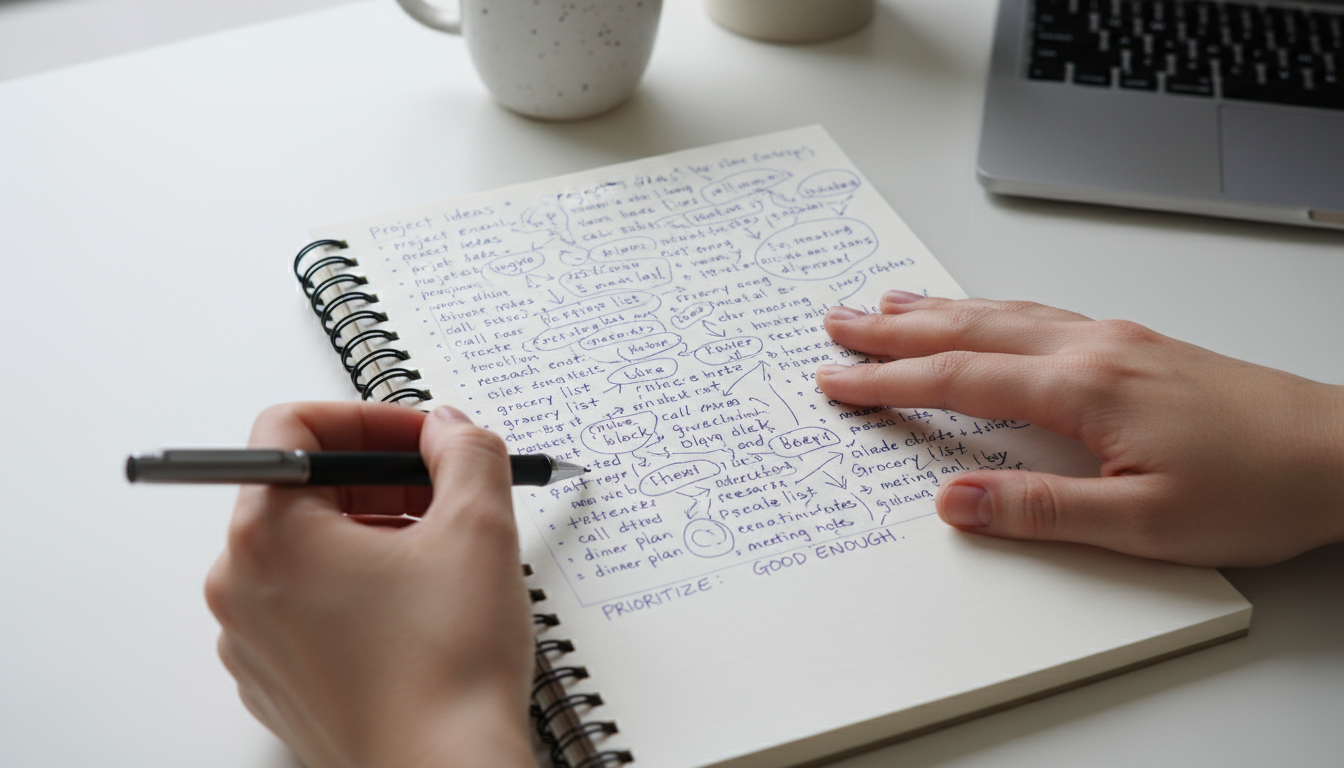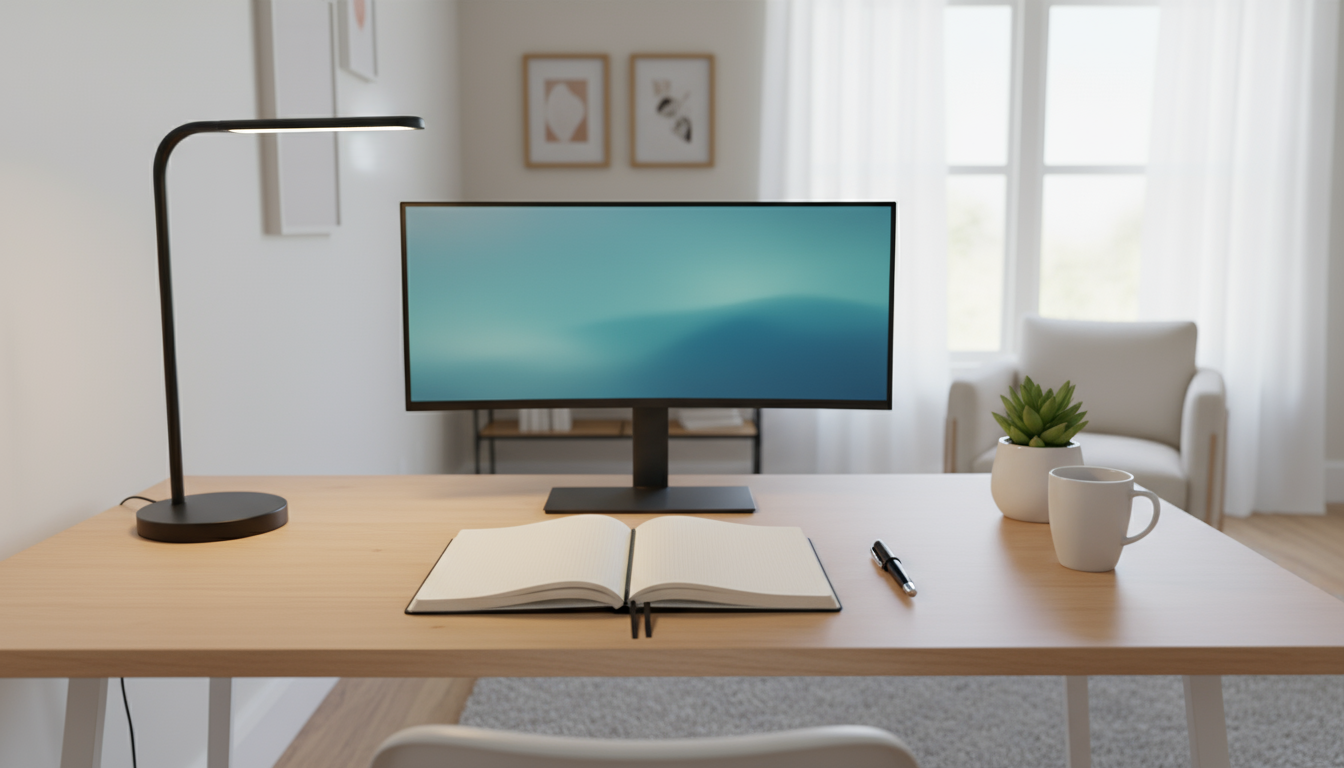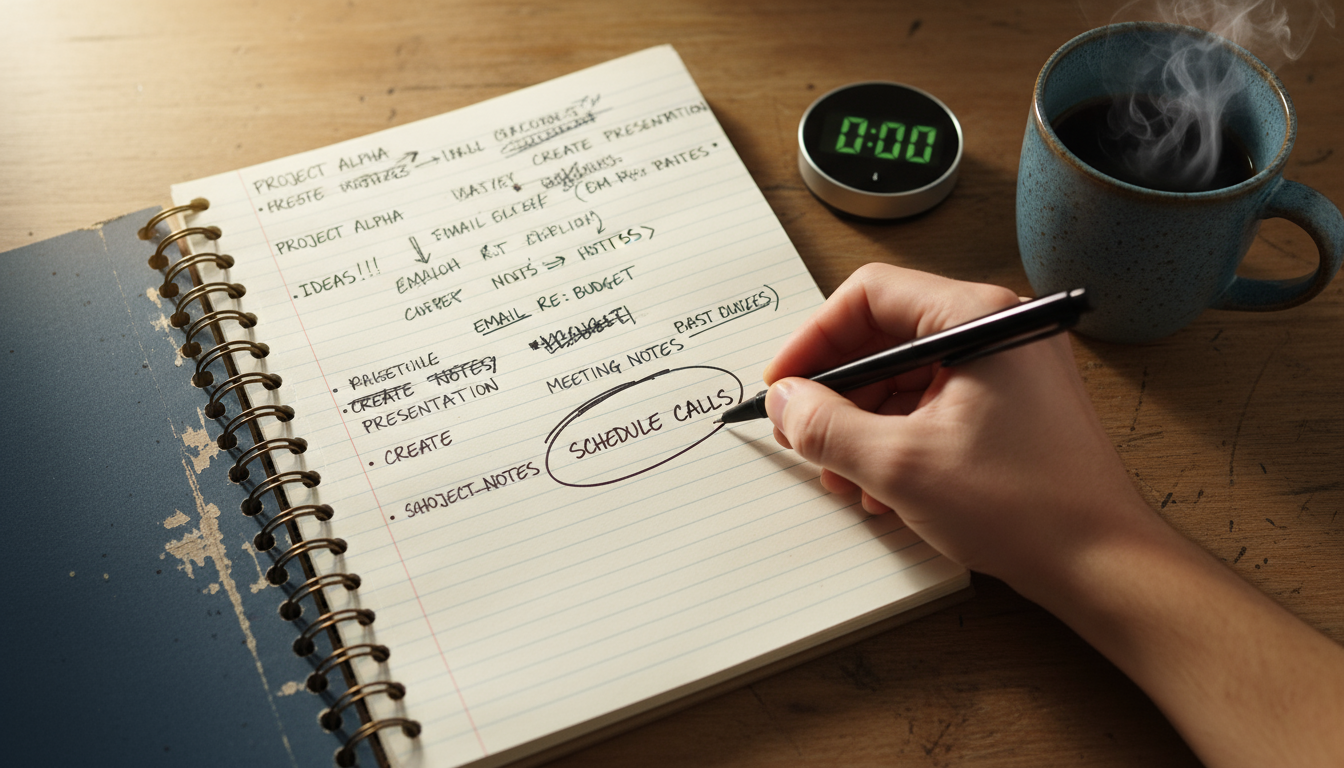
Does your mind ever feel like a web browser with too many tabs open? You sit down to work, but a dozen other thoughts are clamoring for attention. Remember to email Sarah. Did I pay that bill? I need to think about dinner. What was that great idea I had in the shower?
This feeling is mental friction. It is the invisible static that drains your energy before you even start your most important tasks. You feel busy, but not productive. You feel overwhelmed, but not accomplished. It is a frustrating, exhausting cycle, and you are not alone in feeling it.
The modern world is a constant assault on our attention. We are pulled in a hundred different directions by notifications, obligations, and our own racing thoughts. The ability to sustain focus is not a personal failing; it is a skill that needs to be intentionally cultivated. And like any skill, it starts with the right tools and a simple, consistent practice.
What if you could start your day with a clear mind? What if you could quiet the noise and create a calm, focused space to do your best work? You can. The solution is not a complex productivity system or a new, expensive app. It is a simple, powerful, and free ritual called the brain dump.
In this article, we will explore why your attention feels so scattered and how a daily brain dump can become the anchor for your focus. We will walk through practical rituals to structure your day, from a gentle startup in the morning to a peaceful shutdown in the evening. This is not about adding more to your to-do list. It is about creating space. It is about giving your mind the clarity it needs to thrive. Let’s begin.
📚 Table of Contents
- Understanding Your Brain’s Operating System
- The Wandering Mind and Cognitive Load
- The High Cost of Switching Gears
- Riding Your Waves of Energy
- Finding Your State of Flow
- A Practical Toolkit: Daily Focus Rituals
- The Morning Startup Ritual: The Brain Dump Itself
- The Deep-Work Entry Ritual
- Break Hygiene: The Art of the True Break
- The Shutdown Ritual: Closing the Loops
- Your 15-Minute Starter Pack
- Upgrading Your Mindset: Essential Thought Tools
- The Brain Dump in Action: Two Real-World Scenarios
- Frequently Asked Questions About Focus and Brain Dumps
- Q: Should I listen to music or white noise while I work?
- Q: I’ve always been a multitasker. Isn’t it more efficient to do several things at once?
- Q: What if I don’t feel motivated enough to even do a brain dump? Some mornings I just feel completely flat.
- Q: Can I do a brain dump in the evening instead of the morning?
- Q: Is it better to do a brain dump digitally or on paper?
- Your Seven-Day Focus Challenge: From Overwhelm to Clarity

Understanding Your Brain’s Operating System
Before we dive into the “how,” it is crucial to understand the “why.” Why does your focus shatter so easily? Why does your energy seem to vanish by mid-afternoon? Your brain is not a computer that runs at full speed all day. It is a biological organ with its own rhythms, patterns, and limitations. When we work against these natural tendencies, we create overwhelm. When we work with them, we create focus.
Let’s demystify a few core concepts of your mental operating system.

The Wandering Mind and Cognitive Load
Your brain is wired to wander. This was a survival mechanism for our ancestors, who needed to constantly scan their environment for threats and opportunities. In today’s world, that same mechanism scans our internal environment for pending tasks, worries, and ideas. Each of these thoughts is an “open loop.” It is a mental tab that stays open until it is resolved or captured.
This brings us to a key idea: cognitive load. Think of cognitive load as the amount of information your working memory can hold at one time. It is like the RAM on your computer. When you try to keep your to-do list, your worries, and your creative ideas all in your head while also trying to write a report, you are overloading your RAM. Your mental processing speed slows to a crawl. You feel sluggish, forgetful, and easily frustrated. The brain dump is a way to externalize this information, freeing up precious cognitive resources.

The High Cost of Switching Gears
Many of us believe we are good at multitasking. We text while listening to a meeting or check emails while writing a proposal. But neuroscience tells a different story. The brain does not actually multitask. Instead, it performs something called context switching.
Context switching is the act of rapidly shifting your focus from one unrelated task to another. Every time you switch, you pay a mental tax. It takes time and energy for your brain to disengage from the first task and load the context for the second one. Studies from institutions like the American Psychological Association have shown that this process can eat up a significant portion of your productive time. It feels like you are doing more, but in reality, you are performing each task less effectively and burning through your mental energy much faster. The antidote to this is monotasking, or single-tasking: dedicating your full attention to one thing at a time. A brain dump helps you choose that one thing with confidence.

Riding Your Waves of Energy
Your focus and energy are not constant throughout the day. They operate in cycles, known as ultradian rhythms. You naturally move through periods of high-energy focus (around 90 minutes) followed by periods where your brain needs a short break (around 15 to 20 minutes). If you try to power through these cycles and work for hours on end without a real break, you are fighting your own biology. Your focus will inevitably decline, and you will end up feeling depleted.
Recognizing these natural rhythms is key. The goal is to align your most demanding work with your peak energy periods and use your lower-energy periods for rest or less demanding tasks. This rhythm of focused work followed by intentional rest is the foundation of sustainable productivity.

Finding Your State of Flow
When all these elements align—a clear mind, a single task, and peak energy—you can enter a state of flow. Coined by psychologist Mihaly Csikszentmihalyi, flow is a state of complete immersion in an activity. Time seems to disappear. Your focus is effortless. You are fully engaged and performing at your best. This is the state we are all striving for when we sit down to do deep, meaningful work. A brain dump is the first step on the path to flow because it systematically removes the internal distractions that prevent you from becoming fully immersed.

A Practical Toolkit: Daily Focus Rituals
Understanding the theory is helpful, but true change comes from practice. A ritual is simply a practice you do with intention. By building small, consistent focus rituals into your day, you create a structure that supports your attention rather than drains it. Think of these as the building blocks of a more focused life.
Here is a simple framework for your day, anchored by the morning brain dump.

The Morning Startup Ritual: The Brain Dump Itself
This is the cornerstone. Your morning brain dump is the process of getting everything out of your head and onto a different medium, like paper or a digital document. This act of externalizing thoughts quiets the internal noise and provides you with a clear, objective view of what is on your mind.
What is a brain dump? It is an unfiltered, unstructured offloading of your mental contents. It is not a to-do list. It is not a journal. It is a raw data file of your consciousness. It can include tasks, worries, appointments, fragments of ideas, questions, and reminders. Anything and everything that is taking up space in your head belongs in the brain dump.
How to do a brain dump:
- Choose Your Tool: A simple notebook and pen, or a blank digital document. The key is to choose something with minimal friction. Pen and paper can be particularly effective because it feels more tangible and avoids the distractions of a digital device.
- Set a Timer: Start with 10 minutes. The timer creates a gentle container for the practice. It is not an endless task; it is a short, focused exercise.
- Write Without Judgment: For those 10 minutes, write down everything that comes to mind. Do not edit, organize, or censor yourself. Use bullet points, short phrases, or full sentences. The grammar and spelling do not matter. The only rule is to keep your pen moving or your fingers typing. If you feel stuck, just write “I don’t know what to write” until a new thought appears. It will.
- Review and Organize: After the timer goes off, take another 5 minutes to process your dump. This is where you bring order to the chaos. Scan the list and categorize items. You can use a simple system like:
– To-Do Today: Urgent and important tasks for the day ahead. Circle or highlight these.
– To-Do Later: Tasks that need to be done but not today.
– Worries/Concerns: Things you are anxious about.
– Ideas: Creative thoughts or potential projects.
– Appointments: Things that are already scheduled.
Now, your mind is clear. You are no longer trying to hold everything at once. You have a tangible map of your mental landscape.

The Deep-Work Entry Ritual
With your organized brain dump in hand, you can now transition into your first block of focused work. Look at your “To-Do Today” list and ask one question: What is the one thing that will make the biggest impact today? Do not pick three things. Pick one.
- Declare Your Intention: State clearly what you will work on. For example, “For the next 50 minutes, I will only work on drafting the introduction to the project report.”
- Set a Timer: Use a timer for 25, 50, or 90 minutes, depending on your energy and the task. This defines the work session.
- Eliminate Distractions: Put your phone in another room. Close all unnecessary browser tabs. Signal to yourself and others that you are entering a focus block.

Break Hygiene: The Art of the True Break
What you do on your break is just as important as the focused work itself. Scrolling through social media or checking email is not a real break. It just bombards your brain with more information and context switching. True “break hygiene” involves activities that allow your mind to rest and recharge.
During your 5 to 20-minute breaks, try one of these: get up and stretch, walk around the room, get a glass of water, look out a window at something distant, do a few deep breathing exercises, or simply sit with your eyes closed. The goal is to disconnect from input and let your mind wander freely.

The Shutdown Ritual: Closing the Loops
At the end of your workday, a shutdown ritual is the perfect bookend to your morning brain dump. It signals to your brain that the workday is over, preventing work from bleeding into your personal time and causing late-night anxiety.
Take 5 to 10 minutes to:
– Review what you accomplished.
– Look at your brain dump list and migrate any unfinished “To-Do Today” items to tomorrow’s plan.
– Capture any new thoughts or tasks that have come up during the day.
– Briefly decide on your main priority for tomorrow.
– Tidy your physical or digital workspace.
This simple act of closing the loops tells your brain that everything has been captured and it can safely disengage and rest.

Your 15-Minute Starter Pack
Feeling overwhelmed by all this? Start small. Commit to just 15 minutes every morning.
– 10 minutes: Do an unfiltered brain dump.
– 5 minutes: Review the list, circle your single most important task for the day, and ignore the rest for now.
This tiny habit is the foundation upon which all other focus skills are built.

Upgrading Your Mindset: Essential Thought Tools
Practicing rituals like the brain dump is powerful, but pairing them with the right mindset makes them unstoppable. Our thoughts often create more friction than our circumstances. By learning to reframe unhelpful thought patterns, we can make the path to focus smoother and more sustainable.
Here are three mental tools to keep in your back pocket.

Reframe Perfectionism as Progress
Perfectionism is one of the biggest enemies of focus. It is often disguised as a desire for high standards, but at its root, it is a fear of judgment and failure. This fear can cause us to procrastinate on starting a task because we are worried we cannot do it perfectly. It can also cause us to get stuck on minor details, losing sight of the bigger picture.
The brain dump is a fantastic antidote to perfectionism. When you see the full list of everything on your mind, you realize it is impossible to do it all perfectly. This forces you to prioritize and accept “good enough.”
The Thought Tool: When you feel the pull of perfectionism, shift your focus from outcome to process. Instead of saying, “I have to write the perfect report,” say, “I will spend the next 45 minutes making progress on the report.” Your goal is not to be flawless; your goal is to move forward. Celebrate the act of showing up and putting in the effort, regardless of the immediate result. Progress, not perfection, is the mantra.

Actively Reduce Friction
Our brains are wired to follow the path of least resistance. If starting a task feels difficult, we will instinctively avoid it in favor of something easier, like checking email. The brain dump reduces mental friction by clarifying your next step. You can also reduce physical friction.
Friction is any small obstacle that stands between you and your desired action. For example, if your notebook for your brain dump is buried under a pile of papers in another room, that is friction. If your laptop opens to a dozen distracting websites, that is friction.
The Thought Tool: Ask yourself, “How can I make starting this 1% easier?”
– Lay out your notebook and pen on your desk the night before.
– Create a bookmark for your blank digital document.
– Before a work session, pour a glass of water and have it ready.
– Use website blockers to create a distraction-free environment for your focus blocks.
By intentionally removing these small barriers, you make it almost effortless to slide into a state of focus. You are designing an environment that supports your intentions.

Script Your Reset After Derailment
You will get distracted. You will fall off track. It is not a matter of “if,” but “when.” An interruption will occur, a tempting thought will pull you away, or your motivation will dip. The most important skill is not avoiding distraction entirely, but learning how to recover from it quickly and compassionately.
Many of us react to distraction with harsh self-criticism. “Ugh, I can’t believe I just wasted 20 minutes on social media. I have no self-control.” This inner critic only adds a layer of shame and makes it harder to get back to work. A more effective approach is to have a pre-planned, non-judgmental script.
The Thought Tool: Create a simple, two-step reset script for yourself. It could be something like:
1. Acknowledge without judgment: “I notice I’ve been distracted. That’s okay, it happens.”
2. Gently redirect: “I’ll take one deep breath and return my focus to [your task].”
Repeat this script every single time you notice your mind has wandered. The act of noticing is a win in itself. It is a moment of mindfulness. By responding with gentle redirection instead of self-punishment, you train your brain to see distractions not as failures, but as simple opportunities to practice returning to your focus.
These thought tools, combined with your daily rituals, create a robust system for managing your attention. You are not just clearing your mind; you are training it to be a more resilient and focused partner in your work and life.

The Brain Dump in Action: Two Real-World Scenarios
Theory and tools are great, but seeing how they apply in real life can make all the difference. Let’s walk through two common, stressful scenarios to see how our focus toolkit can transform overwhelm into calm, effective action.

Scenario 1: The Tight Deadline
The Situation: Meet anjali. It is 10 a.m., and she has a critical report due to her boss by the end of the day. Her mind is racing. She is thinking about the data she still needs to analyze, the charts she has to create, the introduction she has not written, and her boss’s potential reaction. She is also remembering that she needs to book a dentist appointment and pick up groceries on the way home. She is feeling paralyzed by the pressure and does not know where to start.
Without a System: Anjali tries to jump right into the report. She opens the document, stares at the blank page, and immediately feels a surge of anxiety. To escape the feeling, she opens her email to “just clear a few things out.” An hour later, she has answered a dozen unimportant emails but has made zero progress on the report. Her stress levels are now even higher.
With the Brain Dump Ritual:
- The Startup: Anjali recognizes the feeling of overwhelm. She takes a deep breath, grabs her notebook, and sets a timer for 7 minutes. She dumps everything onto the page: “write intro,” “analyze Q3 data,” “create revenue chart,” “proofread conclusion,” “worry boss will hate it,” “email dentist,” “buy milk,” “check project Slack channel.”
- Organize and Prioritize: She looks at the list. Externalizing her anxiety (“worry boss will hate it”) helps diminish its power. She sees the report broken down into smaller, manageable pieces. She identifies the very first physical action she can take: “open the spreadsheet with Q3 data.” This is her single most important task.
- Deep-Work Entry: Anjali puts her phone on silent, closes her email and Slack, and sets a timer for 50 minutes. Her only goal for this block is to analyze the Q3 data. She has given herself permission to ignore everything else on her list.
- Rinse and Repeat: After the 50 minutes, she takes a 10-minute break to stretch and get water. Then she looks at her list again, picks the next smallest step (“create revenue chart”), and starts another focus block. By breaking the mountain of a task into a series of small hills, she moves from paralysis to steady progress.

Scenario 2: The Noisy Home Environment
The Situation: Meet David. He works from home and shares his space with a partner, two young children, and a dog. The environment is a constant source of interruptions. He struggles to find long stretches of quiet time and often ends the day feeling like he was pulled in a million directions and accomplished nothing of substance.
Without a System: David tries to work whenever he finds a moment of quiet. But because he has not defined his priorities, he often defaults to easy, shallow tasks like checking messages. When an interruption inevitably comes, he gets frustrated, feeling that his important work is constantly being derailed. He feels resentful and ineffective.
With the Brain Dump Ritual:
- The Startup: David wakes up 15 minutes before the rest of the house. He uses this quiet time for a brain dump. He lists out his work tasks, household chores (“fix leaky faucet”), and personal goals (“research summer camps”). He knows his focus time is precious and limited.
- Organize and Prioritize: From his list, he identifies the ONE cognitively demanding task that requires his best energy. Today, it is “outline the marketing strategy.” This is his priority. He accepts that he may not get to anything else of substance, and that is okay.
- Strategic Work Blocks: He communicates with his partner: “I am going into a 90-minute focus block to work on the marketing strategy. Can you be the point person for the kids unless it is a true emergency?” He puts on noise-canceling headphones and gets to work on his one thing.
- Using the Reset Script: The dog barks, and a child asks for a snack. He gets pulled out of his flow. Instead of getting frustrated, he handles the interruption and then uses his reset script: “Okay, that was a distraction. It happens. Taking a breath and returning to the marketing outline.” This non-judgmental reset allows him to get back on track quickly without wasting energy on frustration.
In both scenarios, the brain dump did not magically add more hours to the day. What it did was provide clarity. It helped Anjali and David identify what truly mattered and gave them a simple, actionable starting point, turning a chaotic mental state into a focused plan of action.

Frequently Asked Questions About Focus and Brain Dumps
As you begin to incorporate this practice into your life, questions will naturally arise. Here are answers to some of the most common ones we hear from people starting their focus journey.
Q: Should I listen to music or white noise while I work?
A: This is highly personal, and the answer depends on you and the type of work you are doing. For some, the silence can be deafening, and a little ambient sound can help. The key is to choose audio that supports your focus, rather than competes for it. For many people, music with lyrics can be distracting, as the language-processing parts of your brain get engaged. Consider instrumental music (classical, electronic, or film scores), binaural beats, or ambient sounds like rain or a coffee shop (often called white, pink, or brown noise). The goal is to create a consistent audio backdrop that masks distracting noises and signals to your brain that it is time to focus. Experiment and see what works for you. If you find yourself singing along or paying more attention to the music than your task, it is probably not the right choice for deep work.
Q: I’ve always been a multitasker. Isn’t it more efficient to do several things at once?
A: This is one of the most persistent myths of modern productivity. While it feels like you are being more efficient, extensive research, including work referenced by the National Institutes of Health, suggests the opposite is true. As we discussed, your brain does not truly multitask; it context-switches. Every switch carries a cognitive cost. It fragments your attention, increases the time it takes to complete tasks, and raises the likelihood of errors. Monotasking—giving your full attention to one thing—allows you to get into a state of flow, produce higher quality work, and finish faster. The brain dump helps you do this by giving you the confidence to ignore everything else, knowing it has been safely captured and will be addressed later.
Q: What if I don’t feel motivated enough to even do a brain dump? Some mornings I just feel completely flat.
A: This is a very real and common feeling. Motivation is a fickle emotion; it comes and goes. The secret is to rely on habit and discipline, not motivation. On days when you feel unmotivated, make the task ridiculously small. Do not commit to a 15-minute brain dump and organization session. Commit to writing down just three things that are on your mind. That is it. The goal is not to have a perfect, comprehensive list. The goal is to maintain the habit. Action often precedes motivation. The simple act of picking up a pen and writing three things can be enough to break the inertia and get your mental engine started. Be compassionate with yourself. Some days are just harder than others. Show up, even in the smallest way possible.
Q: Can I do a brain dump in the evening instead of the morning?
A: Absolutely! A brain dump is a versatile tool. While a morning brain dump is excellent for planning and prioritizing the day ahead, an evening brain dump is a powerful shutdown ritual. Doing a “mind sweep” before you go to bed can be incredibly effective for improving your sleep. By getting all the open loops, worries, and next-day tasks out of your head and onto paper, you signal to your brain that it does not need to keep rehearsing them. This can help quiet a racing mind and allow you to fully rest and recharge. You can even do both: a morning dump for planning and an evening dump for closing.
Q: Is it better to do a brain dump digitally or on paper?
A: There is no single “better” way; the best tool is the one you will consistently use. Each has its pros and cons. Analog (pen and paper) is often less distracting. There are no notifications or tempting browser tabs on a piece of paper. The physical act of writing can also help to process thoughts more deeply. Digital (a document or app) has the advantage of being easily editable, searchable, and accessible across devices. However, it also comes with the built-in risk of digital distractions. A good compromise can be to use a very simple, distraction-free text editor. Our advice is to start with pen and paper for a week. See how it feels. Then, if you prefer, try a digital method. The medium is less important than the consistent practice of externalizing your thoughts.

Your Seven-Day Focus Challenge: From Overwhelm to Clarity
You have learned the why, the how, and the mindset behind the brain dump. Now it is time to put it into practice. Knowledge is only potential power; action is where the transformation happens. Reading this article is a great first step, but the real clarity and calm will come from integrating this simple ritual into your daily life.
The goal here is not perfection. It is consistency. We invite you to try a simple, seven-day focus challenge. Do not worry about doing it perfectly. Just commit to showing up each day and seeing what happens. Think of it as an experiment in reclaiming your attention.
Three Simple Actions for the Next Seven Days
For one week, commit to these three small actions every single workday. That is it. This is your entire challenge.
- Start with a 10-Minute Brain Dump. Before you check your email, before you look at social media, before you dive into any work, set a timer for 10 minutes. Grab a notebook or open a blank document and empty your mind. Write down every task, worry, and idea. Just get it all out.
- Choose Your ONE Thing. After the timer goes off, take a few minutes to scan your list. Do not try to make a perfect plan for the whole day. Simply circle or highlight the single most important task you need to work on first. This is your priority. Your only goal is to make progress on that one item before anything else.
- Use Your Reset Script. Throughout the day, you will inevitably get distracted. When you notice your mind has wandered, do not get frustrated. Simply say to yourself, “It’s okay. I’m just noticing I’m off track. Taking one breath and returning to my task.” This is a practice of gentle, non-judgmental redirection.
That is the challenge. It is simple, requires less than 15 minutes to start your day, and has the power to fundamentally change your relationship with your work. You are building the muscle of intentionality. You are training your brain to follow your lead, rather than being pulled around by every distracting thought.
At TheFocusedMethod.com, we believe that focus is not a gift you are born with; it is a skill you can build. It starts with small, sustainable actions that create clarity and reduce mental friction. The brain dump is the most powerful first step you can take on that journey. Give it a try for seven days. Notice how you feel. Notice the clarity it brings. Your calm, focused mind is waiting for you.
Disclaimer: The information provided in this article is for educational and informational purposes only and is not intended as medical or psychological advice. It is not a substitute for professional advice from a qualified healthcare provider. Always seek the advice of your physician or other qualified health professional with any questions you may have regarding a medical condition or mental health concerns.






